Changes in cytochemistry of sensory and nonsensory cells in gentamicin-treated cochleas
- PMID: 12943373
- PMCID: PMC3202711
- DOI: 10.1007/s10162-002-2037-7
Changes in cytochemistry of sensory and nonsensory cells in gentamicin-treated cochleas
Abstract
Effects of a single local dose of gentamicin upon sensory and nonsensory cells throughout the cochlea were assessed by changes in immunostaining patterns for a broad array of functionally important proteins. Cytochemical changes in hair cells, spiral ganglion cells, and cells of the stria vascularis, spiral ligament, and spiral limbus were found beginning 4 days post administration. The extent of changes in immunostaining varied with survival time and with cell type and was not always commensurate with the degree to which individual cell types accumulated gentamicin. Outer hair cells, types I and II fibrocytes of the spiral ligament, and fibrocytes in the spiral limbus showed marked decreases in immunostaining for a number of constituents. In contrast, inner hair cells, type III fibrocytes and root cells of the spiral ligament, cells of the stria vascularis, and interdental cells in the spiral limbus showed less dramatic decreases, and in some cases they showed increases in immunostaining. Results indicate that, in addition to damaging sensory cells, local application of gentamicin results in widespread and disparate disruptions of a variety of cochlear cell types. Only in the case of ganglion cells was it apparent that the changes in nonsensory cells were secondary to loss or damage of hair cells. These results indicate that malfunction of the ear following gentamicin treatment is widespread and far more complex than simple loss of sensory elements. The results have implications for efforts directed toward detecting, preventing, and treating toxic effects of aminoglycosides upon the inner ear.
Figures
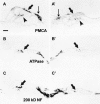
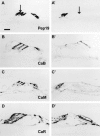
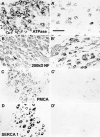

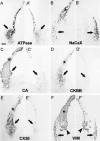


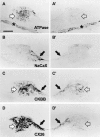
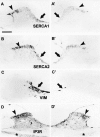
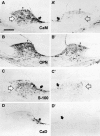
Similar articles
-
Distribution of gentamicin in the guinea pig inner ear after local or systemic application.J Assoc Res Otolaryngol. 2003 Jun;4(2):176-95. doi: 10.1007/s10162-002-2036-8. J Assoc Res Otolaryngol. 2003. PMID: 12943372 Free PMC article.
-
Autoradiographic demonstration of deoxyglucose uptake in guinea pig cochlea.Auris Nasus Larynx. 1985;12(1):1-4. doi: 10.1016/s0385-8146(85)80072-9. Auris Nasus Larynx. 1985. PMID: 4038207
-
Cell-specific accumulation patterns of gentamicin in the guinea pig cochlea.Hear Res. 2015 Aug;326:40-8. doi: 10.1016/j.heares.2015.03.010. Epub 2015 Apr 13. Hear Res. 2015. PMID: 25882166
-
Significance of spiral ligament fibrocytes with cochlear inflammation.Int J Pediatr Otorhinolaryngol. 2000 Nov 30;56(1):45-51. doi: 10.1016/s0165-5876(00)00408-0. Int J Pediatr Otorhinolaryngol. 2000. PMID: 11074115 Review.
-
Gap junction systems in the mammalian cochlea.Brain Res Brain Res Rev. 2000 Apr;32(1):163-6. doi: 10.1016/s0165-0173(99)00076-4. Brain Res Brain Res Rev. 2000. PMID: 10751665 Review.
Cited by
-
[Endolymph homeostasis and Menière's disease: fundamentals, pathological changes, aminoglycosides].HNO. 2008 Dec;56(12):1243-52. doi: 10.1007/s00106-008-1841-8. HNO. 2008. PMID: 19020845 Review. German.
-
Exogenous BDNF rescues rat spiral ganglion neurons in vivo.Otol Neurotol. 2005 Sep;26(5):1064-72. doi: 10.1097/01.mao.0000185063.20081.50. Otol Neurotol. 2005. PMID: 16151360 Free PMC article.
-
Uptake of fluorescent gentamicin by vertebrate sensory cells in vivo.Hear Res. 2006 Mar;213(1-2):64-78. doi: 10.1016/j.heares.2005.11.011. Epub 2006 Feb 8. Hear Res. 2006. PMID: 16466873 Free PMC article.
-
Comparative analysis of combination kanamycin-furosemide versus kanamycin alone in the mouse cochlea.Hear Res. 2011 Feb;272(1-2):108-16. doi: 10.1016/j.heares.2010.10.011. Epub 2010 Oct 31. Hear Res. 2011. PMID: 21044672 Free PMC article.
-
Nuclear factor kappaB deficiency is associated with auditory nerve degeneration and increased noise-induced hearing loss.J Neurosci. 2006 Mar 29;26(13):3541-50. doi: 10.1523/JNEUROSCI.2488-05.2006. J Neurosci. 2006. PMID: 16571762 Free PMC article.
References
-
- Adams JC. Biotin amplification of biotin and horseradish peroxidase signals in histochemical stains. J. Histochem. Cytochem. 1992;40:1457–1463. - PubMed
-
- Anniko M, Thornell L-E, Virtanen I. Cytoskeletal organization of the human inner ear. Acta Otolaryngol. Suppl. (Stockh.) 1987;437:29–54. - PubMed
-
- Bareggi R, Grill V, Narducci P, Zweyer M, Tesei L, Russolo M. Gentamicin ototoxicity: histological and ultrastructural alterations after transtympanic administration. Pharmacol. Res. 1990;22:635–644. - PubMed
-
- Berggren D, Anniko M, Ramaekers F, Virtanen I. Intermediate filament proteins in the embryonic inner ear of mice under normal conditions and after exposure to ototoxic drugs. Acta Otolaryngol. 1990;109:57–65. - PubMed
Publication types
MeSH terms
Substances
Grants and funding
LinkOut - more resources
Full Text Sources

